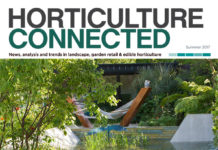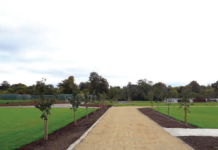Interest in social and therapeutic horticulture has grown in Ireland in the last number of years, and with that, a small but growing number of graduates are gaining employment in the sector. In this feature, Rachel Gerrard Shouldice, ITB graduate and horticultural therapist at the National Rehabilitation Hospital, Dun Laoghaire, and lecturer in horticulture, Rachel Freeman explore the educational and work practice opportunities available in this emerging field
For nearly 20 years I worked in the legal profession as a senior legal executive in a large firm, which I loved. The economic downturn and redundancy gave me time to pause and the opportunity to change direction and return to education.
I have always loved gardening; I find that being outside working in the fresh air clears my head and grounds me. I decided to learn more as a mature student and studied at the National Botanical Gardens, completing my honours year at IT Blanchardstown.
Horticulture is a broad church, offering both academic and practical modules. The lecturers were always approachable and supportive. I found the practical learning placement was a vital component of the learning experience. I majored in market gardening and nursery stock production. I also studied commercial crop production, garden management, plant treatment and integrated pest management, organic growing, and propagation of plants from seeds and cuttings.
INTEREST IN SOCIAL AND THERAPEUTIC HORTICULTURE
With particular interest, I studied social and therapeutic horticulture (STH) at IT Blanchardstown, where alongside the academic theory we also had the practical learning experience of designing and running weekly horticultural workshops for a group of special needs QQI L 3 learners. The experience of engaging with these learners on a weekly basis formed the basis of my learning in STH, both in terms of theory and practice.
The focus of my final year research thesis was on the role of horticulture in integrated substance abuse recovery programmes, exploring the benefits horticulture has to offer service users. The guidance and encouragement of my mentor were invaluable. My research involved an in-depth review of the related published literature, studies and reports and interviewing a number of related service providers including the Peter McVerry Trust, Coolmine Therapeutic Community, Tivoli Training Centre and Thornton Hall Prison.
I worked with Dun Laoghaire Rathdown Parks Department for four summers, during which time I had the opportunity to work with St John of God, Carmona Services Users, with intellectual disabilities, who came to work with us in Cabinteely Park two days a week on their 10-week practical learning placements. We formed a team, together engaging in amenity horticultural tasks such as watering window boxes, weeding display beds, deadheading and general maintenance of the park. The aim of these activities was to prepare the learners for independent living and sheltered employment.
WORKING IN SOCIAL AND THERAPEUTIC HORTICULTURE
Since attaining my BSc (Hons) in horticulture, I have volunteered with the Peter McVerry Trust, assisting the horticulturist at their residential community detox centre in north county Dublin.
In addition, I design and construct, restore and maintain gardens for private clients, most recently upgrading the playground and restoring the willow dome of a primary school in Darndale. I was a finalist on RTE’s Super Garden 2016 TV series, which was an incredible experience. I designed and constructed a cottage style garden for a young family.
WORKING AS A HORTICULTURAL THERAPIST
Since September 2016, I have been employed as the horticultural therapist at the National Rehabilitation Hospital, Dun Laoghaire. This facility provides specialist medical rehabilitation, for patients who have acquired a physical or cognitive disability.
The skills, knowledge and attitude I have developed from working with the above services form the basis of my approach with NRH patients. I have also obtained a certificate in training, delivery and evaluation, QQI L 6 with an emphasis on communication skills and preparing lesson plans, which has assisted me in devising horticultural therapy sessions.
Patient needs are at the heart of any therapeutic horticulture session and in the process of devising these sessions, I familiarise myself with the individual patient’s needs by linking in with the occupational therapist and reading the referral notes which guide me in creating sessions tailored to meet the needs of the group, and/or individuals.
THERAPEUTIC USE OF HORTICULTURE IN PRACTICE
Using horticulture as the therapeutic vehicle, the activities are designed to build physical stamina and strength through meaningful tasks. The sessions enable individuals develop better task focus, increase self-esteem, and give opportunities for experiential learning.
I am responsible for the day to day running of the occupational therapy garden and therapeutic horticulture facility. The facility provides a wide and varied spectrum of horticultural activities, such as mixing compost, seed sowing, picking out seedlings, potting on, which assist with sitting and standing gait, fine motor skills, and cognitive understanding of sequential steps.
Watering with watering cans or a hose assists with balance, reaching, lifting and bending. Lawn mowing, hedge cutting, digging, hoeing, and hand weeding increase physical fitness, strengthen muscles and improve stamina.
Setting out and planting rows of vegetables, mulching, pruning and harvesting offer insight to the circle of the seasons. Along with the cognitive and physical benefits, there are emotional and behavioural benefits, such as increased confidence and ability to manage anxiety, depression, anger and stress.
NRH patients in receipt of care become carers themselves through tending to the plants, which cultivates the urge to nurture and to take care of themselves, others, and the earth.
Patients prepare produce for use in their occupational therapy kitchen, where they may cook their own meals, increasing awareness of food provenance and nutrition. Patients are encouraged to participate in plant sales which help fund the garden, giving them a sense of achievement. They contribute to the maintenance of the garden, which encourages a sense of ownership and pride in their work.
The garden offers a quiet reflective space to address issues of bereavement which may arise in counselling sessions and allows them to process emotions. It is also a social hub. Patients chat away to each other as they work, swap stories and have the craic; laughter releases tension, lifts spirits and makes it an enjoyable and fun activity. The patients look forward to their next session.
Meaningful activities, outside in the fresh air, in contact with the soil, listening to buzzing bees and birdsong while working with nature, offer benefits specific to horticulture as a therapeutic modality.
Sessions are patient-centred, focusing on their goals and working to achieve the best possible outcome. At the end of each session, I provide detailed feedback to the interdisciplinary team, noting individual’s challenges, progress and discussing plans for future sessions.
Social and therapeutic horticulture is not a stand-alone treatment, but I strongly believe that it is an integral part of the integrated, interdisciplinary, rehabilitative programme.
EDUCATIONAL OPPORTUNITIES AT ITB IN SOCIAL AND THERAPEUTIC HORTICULTURE
Social and therapeutic horticulture education spans all four years of the BSc horticulture programme at ITB. The delivery takes a very hands-on, practical approach to learning, allowing students opportunities within this general horticulture degree to focus their studies on STH, if desired. Garda vetting is mandatory for anyone considering a career in the sector. As part of induction, ITB vets all students ahead of engagement with STH projects.
All first-year students partake in horticulture in the community module. This is where they get their first taste of STH whilst working off-campus with a community group engaged in horticultural activities. Placement in year two, with the Green Bubble Project at St Mary’s Hospital (and others) in the Phoenix Park, offers a further opportunity to engage and develop STH skills.
In the third and fourth years students with an STH focus have the opportunity to explore in depth, the current research and theoretical foundations of STH through their research methods module, and thesis. Year four provides students with a dedicated elective module in STH. This module is focused on the application of theory to practice, and student learning is very much hands-on. Students design and run weekly horticultural workshops for adult learners from the Daughters of Charity engaging in a QQI L 3 module. In this regard, the opportunity of working directly with various STH groups, we believe at this level, our course is unique in Ireland.
If you are interested in doing the degree, either on a part-time of full-time basis and in particular if you want to focus on STH, please get in touch Rachel.freeman@itb.ie ✽
  |
  |








